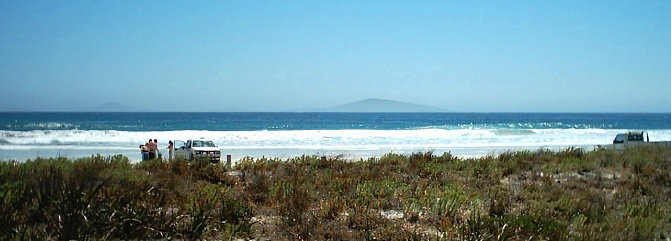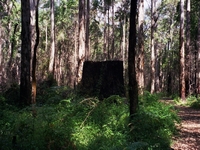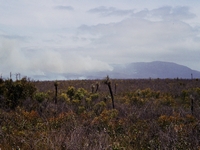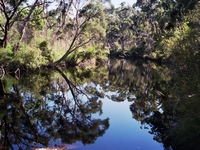Australia So Much to See


In January 2005 we looked for cooler places as we toured the Karri forests and the south coast of Western Australia
While we swam in the bay, a fishing boat came in to anchor
for the night.
Next morning we followed the walk trail up Mount Melville, where there is always something flowering in
the scrub. A further walk took us to the edge of the
Following the river to the beach, we crossed the hill back
to the campsite, looking back to the inlet.
There is an old wool shed constructed from local spongelite stone near the
campsite. This soft rock was formed more than 36 million years ago when the area where it is now quarried in the
Moving on the next day, we had lunch by the river at the
At the old Quaalup homestead, where much of the
original farm is now part of the
The old barn, originally two storeys, had collapsed when it was vandalised. Much of the homestead
had also been vandalised, and it is now being restored in keeping with the era.
The
At Point Ann, whale watching platforms look across
turquoise water. It was not the time of the year to see whales, but we watched dolphins at play.
From Hopetoun, we followed
the coastal road, stopping at
The
While we were at Esperance, we
heard of a devastating fire on the Eyre Peninsula; the way we were heading. With the fires we had left behind fresh in our minds,
our thoughts turned to these people and their livestock.
We followed the coast east, calling in at scenic bays and
beaches with clear turquoise water, with numerous islands of all sizes.
At Thistle Cove there were some interesting
rock formations. Whistling Rock has been carved out by the wind, and emits a whistling sound in the breeze. The cove looked
calm, but waves were crashing onto the rocks below us.

Taking a short January holiday in 2005, we planned to stay close to the south coast to avoid the heat.
We headed out travelling
through the familiar places of Manjimup, Pemberton and Northcliffe. We intended to roughly follow the coastline, stopping
in at places we hadn’t previously seen along the way.
After climbing the granite hill Mount Chudalup which overlooks
We then drove through
karri forests and took a walk through a forest that was clear felled 50 years prior. A huge karri tree known as the Boorara
Tree that was once part of a network of fire tower tree lookouts had been trimmed when it became unsafe and the top section was on
display at the car park.
Hot and tired after our long walk to Lane Poole Falls on the Canterbury River, which had no
water at this time of the year, we decided that with the mild weather, there would be little fire danger and it would be safe to stay. We had a memorable and peaceful night amongst the karri trees.
To the north of
At Mount Frankland, we took the walk around the granite mount and up to the top. It was quite a climb; some of it included
a section of ladder. The fire look out man was around our age, and I commented how fit he must be doing the climb every day
– he replied, no, you just get used to the pain. Since our visit, a new walkway and viewing platform has been built.
Climbing
higher we looked inland across forests. The 360º views from the top included inland and towards the coast with a directional
dial pointing out all the features.
Between
We
hadn’t been to
Near
After
driving straight through
We had not heard about this fire, as at the same time, we had a fire which burnt
out almost half our Shire, only being stopped as it entered the town and burnt two houses there. Another even larger fire the
same day at Tenterden, where loss of live as well as property occurred, had dominated the media coverage. Both of these fires
were started by electricity lines. It was to prove a very bad fire season across the country.



Cape Le Grand National Park was beautiful with walk trails and camp sites. The camp sites were full so we couldn’t stay to climb
Frenchman’s Peak and enjoy the longer walks.
Huge granite boulders through the park were striated, as can be seen on Frenchman’s
Peak. Beaches were white against a vivid turquoise sea.
Leaving
With no where to stay, we moved inland a little way and found a patch of bush near a blue gum
plantation. It was very hot so we used the generator and air conditioner for the first time. Beautiful – after a couple
of hours it was too cool inside then caravan.
At Duke of Orleans Bay there is a resort, and it appeared they hired out quad
bikes in all sizes for people to use on the beaches.
There were just a few people in the surf at
Moving further east, we entered the
We looked across to Cape Arid, with Mount Arid virtually obscured by rain, and chose not to venture further into the
park. We could not take the caravan through the sandy 4wd tracks.
We returned to Condingup and headed north on Parmango
Road through farms to Beaumont wheat bin, then into woodlands and later scrublands.
The abandoned Deralinya station homestead
is surrounded by scrub. The old stations here are now all run as one holding. Campers are welcome at the homestead, but
asked not a leave rubbish, which unfortunately some have not heeded.
We joined the Eyre Highway near Balladonia and continued east.
At Eucla we went to the Old Telegraph Station ruins, now buried in white sand. At Eucla, the sand dunes give way to cliffs.
Continue reading for the homeward stretch when we returned to Western Australia
WA – the return leg
After crossing the Nullarbor through light rain showers and a stiff south westerly wind, we finally
found our way to the Cocklebiddy Cave. The rough track is not signposted and had eluded us previously. We did not climb
down into the cave’s entrance, but looked into the opening of Australia's (and one of the world's) longest underwater cave. It is the only source of water for birds. Thin kangaroos sat in the shade under every bush. There was little to eat, and
the only water source for them was the leaves of the scrub. Just trackside on the way back to the highway, we counted 62 kangaroos.
The Nullarbor is unique as it is the only desert region with extensive caves that contain large quantities of water. This
water varies in salinity, and being 90 to 100 metres deep underground is inaccessible to all but birds.
Close to the Eyre
Highway at the Caiguna Blowhole, air rushes out of the hole at 72 kilometres per hour. It is like feeling the Earth is breathing
The
region is a 270,000 square kilometre slab of limestone, the largest in the world, and it is riddled with caves, blow holes and sink
holes. For safety reasons, access to many of these caves is restricted to all but experienced caving groups.
Stopping
for lunch at a rest area, we were surprised when a coaster camper pulled in – our friends we had missed at Windy Harbour. A
change of plans meant they had left on their lap a couple of months earlier than previously planned and they were heading east. At the next rest area we pulled in to, there was a Bushtracker caravan similar too and the same age as ours. The owners had
been basically on the road in their 18’ home for seven years.
We took a different route home, taking the new road from Norseman towards Hyden. This has a well laid out trail of signed features, including rocks and the Lake Johnston salt lake. See more about this road and The Granite Woodlands Discovery Trail in 2007 travelogues and 2019.
See 2005 Nullarbor and Eyre Peninsula travelogues and more for the South Australian section of this trip.